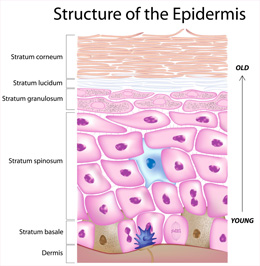Skin Biology
Skin is designed to provide protection from the external environment, including sunlight, heat, cold, injuries and infection. It is involved with body temperature regulation as well as immunity and produces protective oils as well as vitamin D. There are two layers, the epidermis is the outer layer, and the dermis is the inner layer. The dermis contains the blood and lymph vessels, hair follicles and glands.
 The epidermis is made up of flat, scale-like cells called squamous cells, also known as keratinocytes. These are formed through successive maturation of cells that are formed on the base of the epidermis called Basal cells. Basal cells are soft and round compared with flat and hard squamous cells. Also found scattered along the base of the epidermis are cells called Melanocytes. These are the cells that produce melanin and are responsible for your skin colour.
The epidermis is made up of flat, scale-like cells called squamous cells, also known as keratinocytes. These are formed through successive maturation of cells that are formed on the base of the epidermis called Basal cells. Basal cells are soft and round compared with flat and hard squamous cells. Also found scattered along the base of the epidermis are cells called Melanocytes. These are the cells that produce melanin and are responsible for your skin colour.
Skin cancer is the lesion that results from uncontrolled growth of abnormal skin cells. It occurs when unrepaired DNA damage to skin cells (most often caused by ultraviolet radiation from sunshine or tanning beds) triggers mutations (genetic defects) that lead the skin cells to multiply rapidly and form malignant tumors. Cancerous tumors may spread, invading and damaging nearby tissue. In some cases, skin cancers can spread to vital organs, becoming deadly.
Australia has the highest rate of skin cancer in the world. Two out of three Australians will be treated for skin cancer during their lives. Every time our skin is exposed to UV radiation, the structure of our skin cells changes. Too much UV exposure can cause irreversible damage to the DNA of skin cells and one damaged cell can start a deadly melanoma growing. Tanning, whether from sunlight or solariums can lead to skin damage, premature ageing, eye damage and skin cancers.
Skin cancers are grouped into two types, either non-melanoma or melanoma. Non-melanoma skin cancers are the most common type of skin cancer and arise from the squamous and basal cells. These are referred to SCC and BCC respectively. A type of pre-cancerous growth of squamous cells is known as an actinic keratosis, or sunspot. These cancers do not usually spread to other parts of the body, although they do require prompt treatment to prevent this from happening. Melanoma arises from melanocytes, and whilst it is less common, it is also the most dangerous as it has the ability to spread to other parts of the body.
What is Your Skin Cancer Risk?
Calculate your level of risk of developing a skin cancer from exposure to the sun.

